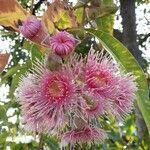A medium sized tree. It grows to 8-15 m tall. It spreads 3-10 m wide. The bark is rough. The young branches droop. The leaves are large and leathery. The blade is 10-30 cm long by 4-10 cm wide. The midrib is prominent. The young leaves are much larger. The flowers are large and white or pink. They are in groups of 3-7 on short thick stalks. The occur at the ends of branches. The fruit is a thick barrel-shaped woody capsule. It is 3.5-4 cm long by 2.5-3 cm wide. Sometimes the fruit has ribs.


